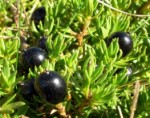Scientific Name: Coprosma ernodeoides
Endemic: Maui and Hawai’i
Description: Very cool looking low sprawling shrubs, which in most cases look like ground covers. Although the main look of the plant is herbaceous, to the touch it is very stiff and rigid. Tough, tiny leaves that are triangular in shape cover the thick stems. Small, creamy yellowish-white flowers develop from within the leave axis and when pollinated form numerous shiny black fruit from which this plant is named. Yup, if you haven’t figured it out already, kukaenene means nene poop. Not for the smell, but for the look. Each tiny fruit kinda looks like a black licorice jellybean which also happens to look like the droppings of nene birds. What’s even more interesting is that these fruits are one of the favorite foods of the nene.
Distribution: In the wild this plant is usually found in the sub-alpine forests of Haleakala on Maui and on the Big Island in open lava fields anywhere between 3000-7000 ft. in elevation.
Landscape Use: Surprisingly, even though this plant found at such high elevations it does amazingly well at our nursery in Kane’ohe on O’ahu at about 100 ft. elevation. It looks great planted around larger landscaping stones. Plant kukaenene in full sun with well drained soil, it has few pests and needs very little water to thrive. It also does great as a potted plant for your Lanai.
Cultural Uses: There are no known uses of this plant culturally but it is an important component to the ecology of the upper dry forests and sub-alpine regions of Maui and Hawaii. It is crucial to protect this plant’s habitat not only for the plant itself but for other animals like the endangered nene goose, our state bird, which depend on it and other native plants so greatly.
Additional Info: Other names that this plant goes by include: ‘aiakanene, leponene, nene, and punene.
Kukaenene
